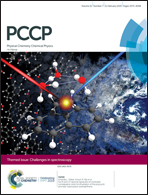Theoretical screening of promising donor and π-linker groups for POM-based Zn–porphyrin dyes in dye-sensitized solar cells†
Abstract
A series of Zn–porphyrin dyes with different donor and π-linker groups based on the dye SM315 were systematically investigated to screen highly efficient candidates based on density functional theory (DFT) and time-dependent DFT (TD-DFT) calculations. Compared with SM315, dye 1 not only has stronger and broader absorption spectra and larger intramolecular charge transition (ICT) parameters, but also has a larger maximum short circuit density (JmaxSC) and an open-circuit photovoltage (VOC) due to the insertion of polyoxometalate (POM). In addition, dye 3 with an electron donor 3-ethynyl-7-(4-methoxyphenyl)-10-methyl-10,10a-dihydro-4aH-phenothiazine (D3) exhibits better photovoltaic performance among dyes 1–3 due to its broadest absorption spectra and largest JmaxSC, hence, D3 can act as a promising donor candidate for the construction of efficient dyes. Furthermore, the performance can be further improved by replacing the π-linker 2,1,3-benzothiadiazole (dye 3) with benzo[1,2-b:4,5-b′]difuran-2,6-dione (dye 4) and pyrrolo[2,3-f]indole-2,6(1H,5H)-dione (dye 5). Compared with dye 3, dyes 4 and 5 possess broader absorption spectra and light harvesting efficiency curves, larger ICT parameters, JmaxSC and conduction band energy shift. In particular, dye 4 might obtain a larger short-circuit photocurrent density, and dye 5 might obtain a larger VOC.



 Please wait while we load your content...
Please wait while we load your content...